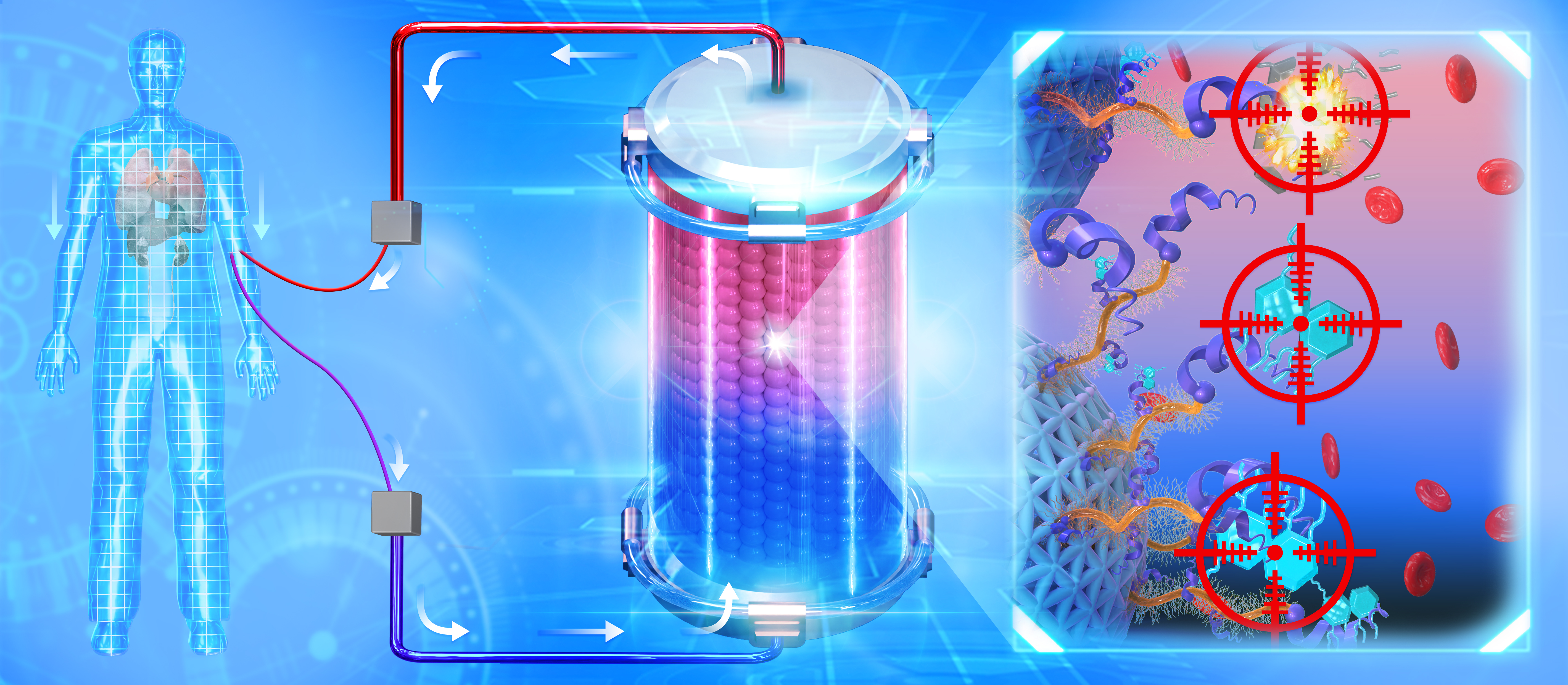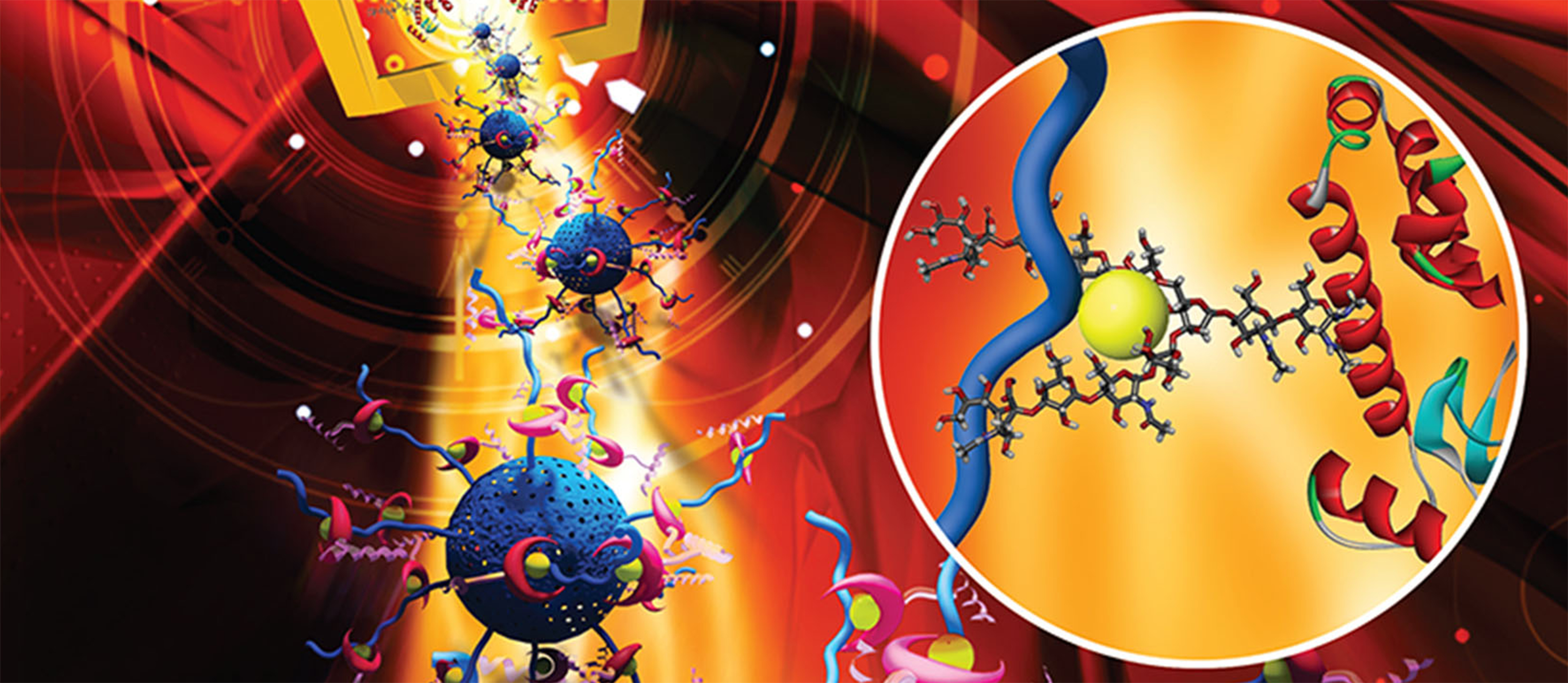- English
1. Biomolecule responsive polymers and bio-applications
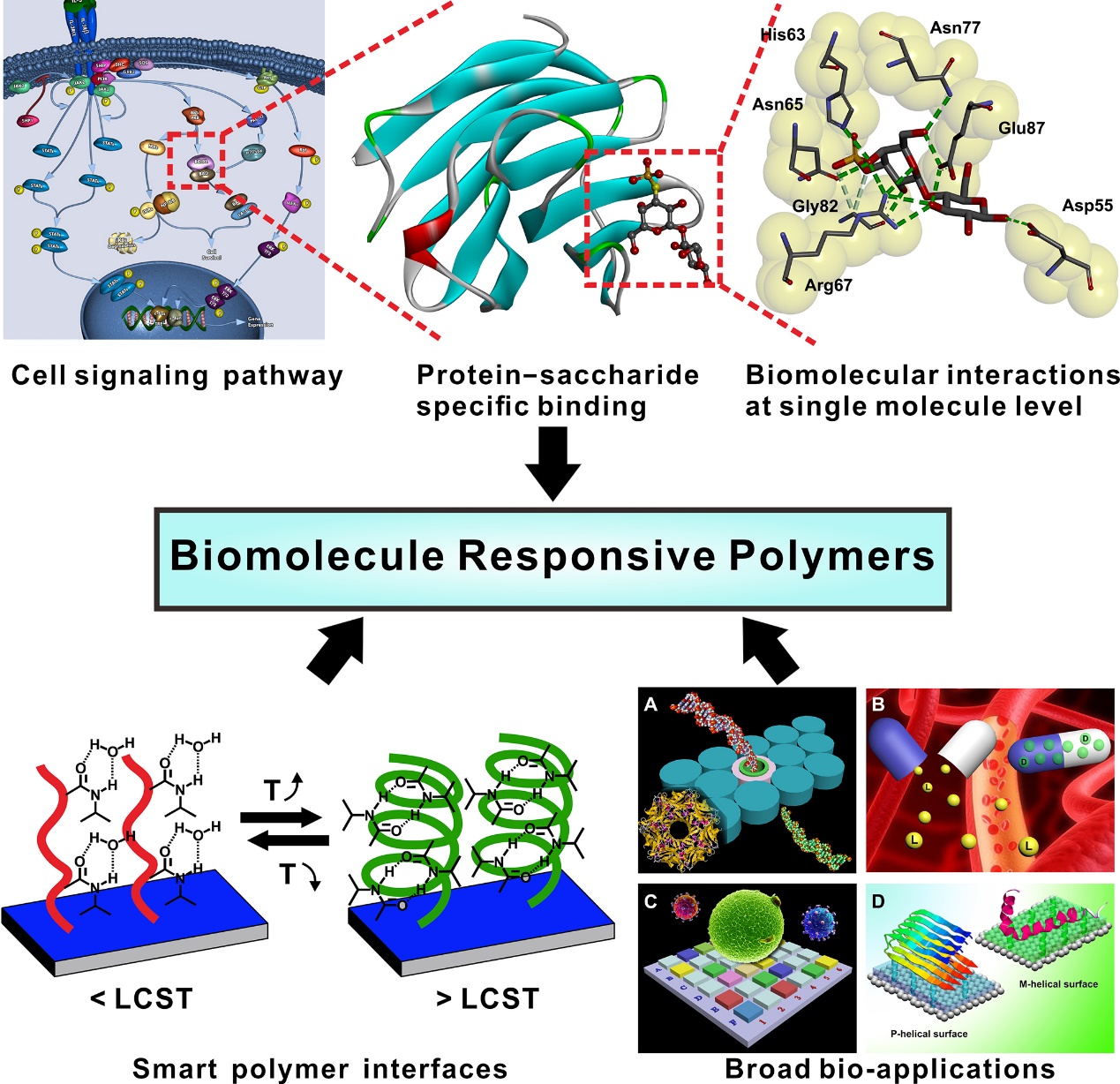
Life systems strongly rely on biomolecular interactions, such as DNA-protein, antibody-antigen, protein-glycan, protein-drug interactions, to perform various bio-functions, which further modulate a wide variety of cellular behaviors. Precise molecular recognition and highly specific interaction between two biomolecules are the basis and prerequisite for biomolecules performing their bio-functions. Through learning and mimicking the specific biomolecule interactions, and integrating the conformational transition of smart polymer chains, a series of biomolecule-responsive polymers could be developed, which well satisfies the high demands of “Precision Medicine”, also called “Individual Therapy”. Owing to the substantially higher recognition and capture efficiency of the materials, biomolecule-responsive polymers and corresponding devices will find broad applications in bio-separation, bio-analysis, controllable drug release, biochips, protein conformational modulation and tissue engineering. This direction integrates multiple research fields, including smart polymer, host-guest chemistry, micro-/nano-devices, precise measurement, biochemistry, medicine, we anticipate that it would grow up into a hot research topic in the near future.
2. Smart enrichment materials for post-translational modification (PTM) proteomics
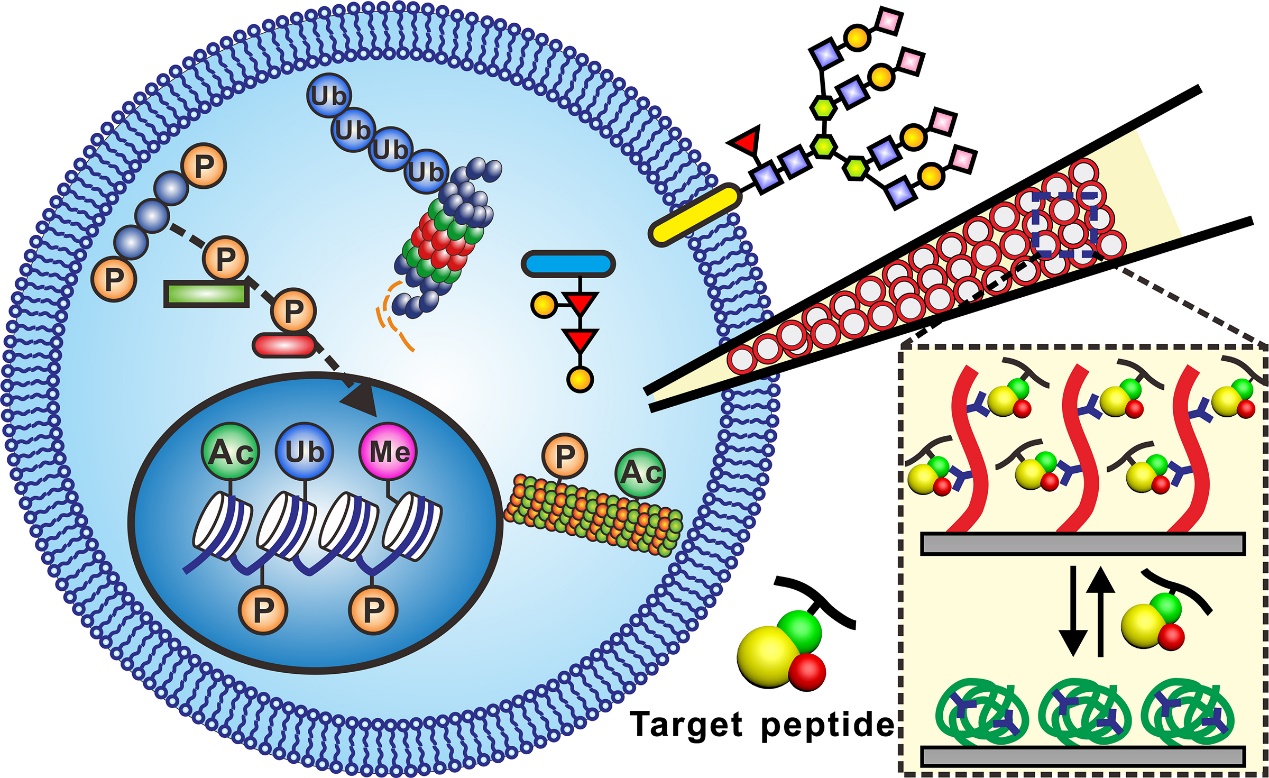
PTM-proteomics is one of the leading edge and hot research topics in the fields of biology and medicine. Owing to powerful capture capacities of phosphorylated peptide or glycosylated peptide enrichment materials, the research of protein phosphorylation and glycosylation develop rapidly, discovering a series of cellular signal pathways that are closely related to cell apoptosis, tumorigenesis, immune response and neurodegenerative diseases, which provide solid supports for the early diagnosis of disease, effective treatment and target drug development.
However, except for the well-known protein phosphorylation and glycosylation, there are more than three hundred PTM types, including the most typical ones, such as methylation, acetylation, ubiquitination and others. The capture of these PTM-proteins or peptides strongly relies on antibodies, which usually suffer from low enrichment efficiency, high cost and easier deactivation. The lack of high-efficiency artificial materials severely constrains related research. Therefore, the development of precise enrichment materials, particularly those based on biomolecule-responsive polymers, will have broad application prospects, capable of providing a series of powerful material tools for in-depth biological and medical research. Ref: Qing, et al. New Opportunities and Challenges of Smart Polymers in Post-Translational Modification Proteomics, Adv. Mater. 2017, 29, 1604670.
3. Precise glycan capture and analysis

Carbohydrates, glycoproteins and glycoconjugates widely exist in living system and play vital roles in numerous biochemical processes. In addition to the well-known roles of glucose as fundamental energy source of living cells and intermediate products of metabolism, glycoprotein has been discovered to participate in most life processes, including protein folding, stability and transport of proteins, mediation of inflammatory response, regulation of leukocyte cell adhesion, control of angiogenesis and blood clotting. Glycosylation is one of the most common and important types of protein post-translational modifications in mammalian cells. Subtle alteration of one monosaccharide in immunoglobulin G (IgG) glycan might remarkably change the glycoproteins’ biological functions. Increasing evidence has proved that altered or abnormal expression of glycans on glycoproteins is closely related to many diseases, such as oncogenesis, cancer transformation and progression. Importantly, more than 50% of cancer biomarkers used in clinical diagnosis are glycoproteins, for examples, alpha-fetoprotein (CA 125) and mucin epitopes (CA15-3). Thus, the exploration and discovery of protein glycosylation has become a new interdisciplinary research of chemistry, biology and biopharmaceuticals.
Glycans contain an abundance of information owing to their complex carbohydrate composition, different branched structures and linkage types, which constitute a mysterious “glycoworld”. However, it is extraordinarily challenging to analyze the mysterious “glycoworld”, which requires the identification of both glycosylation sites and glycan structures simultaneously. To decode the glycoworld, it is highly important to enrich glycopeptides or separate glycans with low abundance from complex biosamples, which requires the development of various glycopeptide or glycoprotein enrichment materials and tools. In addition, the analysis of delicate structures of glycans is more challenging, which strongly relies on the combination of high resolution MS and two-dimensional NMR, sufficient glycan samples with high purity and well trained analysts are needed urgently. We are devoting our efforts to develop various advanced glycan-specific materials and devices to solve this puzzle problem of glycan analysis and decoding. Ref: Qing, et al. Recent Advances in Hydrophilic Interaction Liquid Interaction Chromatography Materials for Glycopeptide Enrichment and Glycan Separation, TrAC Trends in Anal. Chem. 2020, 124, 115570.
4. Smart bio-separation materials

Tremendous advance of life science and biotechnology industry has raised the higher requirement for conventional bio-separation. Currently, chromatographic and related separation techniques have been refined to such a degree that they present efficient separation capacity towards complex samples in fields like pharmaceuticals, proteomics, and food industry etc. However, new breakthroughs, including higher selectivity, more controllable separation mode, lower cost, and mild operation conditions, in various affinity separation techniques are still highly desirable in complicated application scenarios. Smart materials, particularly stimuli-responsive polymer, which could reversibly change their structures and properties in response to the external stimuli provide an ideal solution to upgrade conventional separation strategies, and endow them with smart traits, which is, regulating the affinity between the analyte and separation matric to achieve the controlled capture and release of the analyte of interest.
In general, the entire bio-separation process involves a series of variables, including mass transfer, surface wettability, solid-liquid partitioning, conformation matching and binding affinity, which directly determine the separation performance, and even the success or not in separation. This provides us broad space to upgrade the conventional separation strategies and endow them with intelligent traits, and to further improve the separation performance in more complicated application scenarios. Despite considerable progress has been witnessed over the past few years, there are still some opportunities and challenges ahead for the development of smart bio-separation materials. Ref: Qing, et al. Smart Bio-Separation Materials, TrAC Trends in Anal. Chem. 2020, 124, 11558.
5. Discovery of chiral effect
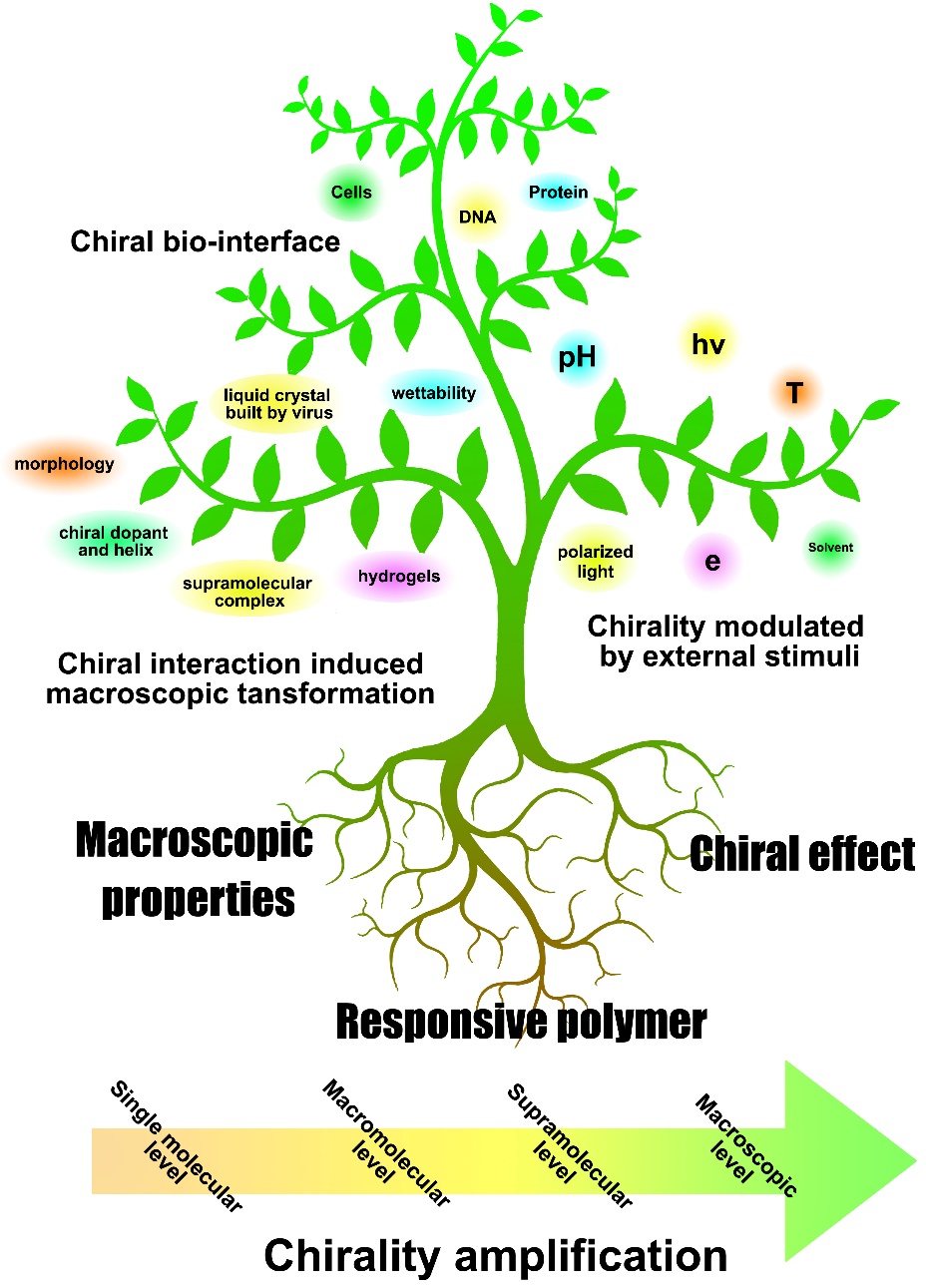
Chirality is one of most typical characteristics of living system, chiral molecules and chiral effects are ubiquitous in the world, from the single molecular chirality, helical chirality of helical polymers, proteins and DNA, anisotropic directions at the macroscopic level, to helicoidal nebula in the universe. Discovery of the origin of chirality, chiral assembly and chiral amplification is one of the 25 most important scientific problems in the 21st century. Meanwhile, taking advantages of the stereoselective interactions between two biomolecules, a series of biomolecule precise recognition materials could be developed. Weak chiral recognition signals could be captured, transferred and amplified into macroscopic property changes of the materials. It will be very interesting to discover fantastic chiral effects, to observe delicate chiral interactions, and to construct various chiral molecule-sensitive devices. Ref: Qing, et al. The Transformation of Chiral Signals into Macroscopic Properties of Materials Using Chirality-Responsive Polymers, NPG Asia Materials, 2012, 4, E4.


